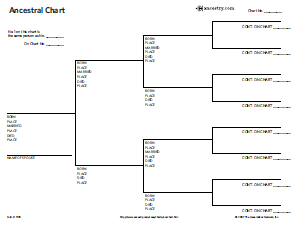| |
1 |
2 |
3 |
4 |
5 |
6 |
7 |
8 |
9 |
10 |
| 1 |
Common Ancestor |
Son or Daughter |
Grandson or Daughter |
Great Grandson or Daughter |
2nd Great Grandson or Daughter |
3rd Great Grandson or Daughter |
4th Great Grandson or Daughter |
5th Great Grandson or Daughter |
6th Great Grandson or Daughter |
7th Great Grandson or Daughter |
| 2 |
Son or Daughter |
Brother or Sister |
Niece or
Nephew
|
Grand Niece
or Nephew
|
Great Grand Niece or Nephew
|
2nd Great Grand Niece or Nephew
|
3rd Great Grand Niece or Nephew
|
4th Great Grand Niece or Nephew
|
5th Great Grand Niece or Nephew
|
6th Great Grand Niece or Nephew
|
| 3 |
Grandson or Daughter |
Niece or Nephew
|
First Cousin |
First Cousin Once Removed |
First Cousin Twice Removed |
First Cousin Three Times Removed |
First Cousin Four Times Removed |
First Cousin Five Times Removed |
First Cousin Six Times Removed |
First Cousin Seven Times Removed |
| 4 |
Great Grandson or Daughter |
Grand Niece or Nephew
|
First Cousin Once Removed |
Second Cousin |
Second Cousin Once Removed |
Second Cousin Twice Removed |
Second Cousin Three Times Removed |
Second Cousin Four Times Removed |
Second Cousin Five Times Removed |
Second Cousin Six Times Removed |
| 5 |
2nd Great Grandson or Daughter |
Great Grand Niece or Nephew
|
First Cousin Twice Removed |
Second Cousin Once Removed |
Third Cousin |
Third Cousin Once Removed |
Third Cousin Twice Removed |
Third Cousin Three Times Removed |
Third Cousin Four Times Removed |
Second Cousin Five Times Removed |
| 6 |
3rd Great Grandson or Daughter |
2nd Great Grand Niece or Nephew
|
First Cousin Three Times Removed |
Second Cousin Twice Removed |
Third Cousin Once Removed |
Fourth Cousin |
Fourth Cousin Once Removed |
Fourth Cousin Twice Removed |
Fourth Cousin Three Times Removed |
Fourth Cousin Four Times Removed |
| 7 |
4th Great Grandson or Daughter |
3rd Great Grand Niece or Nephew
|
First Cousin Four Times Removed |
Second Cousin Three Times Removed |
Third Cousin Twice Removed |
Fourth Cousin Once Removed |
Fifth Cousin |
Fifth Cousin Once Removed |
Fifth Cousin Twice Removed |
Fifth Cousin Three Times Removed |
| 8 |
5th Great Grandson or Daughter |
4th Great Grand Niece or Nephew
|
First Cousin Five Times Removed |
Second Cousin Four Times Removed |
Third Cousin Three Times Removed |
Fourth Cousin Twice Removed |
Fifth Cousin Once Removed |
Sixth Cousin |
Sixth Cousin Once Removed |
Sixth Cousin Twice Removed |
| 9 |
6th Great Grandson or Daughter |
5th Great Grand Niece or Nephew
|
First Cousin Six Times Removed |
Second Cousin Five Times Removed |
Third Cousin Four Times Removed |
Fourth Cousin Three Times Removed |
Fifth Cousin Twice Removed |
Sixth Cousin Once Removed |
Seventh Cousin |
Seventh Cousin Once Removed |
| 10 |
7th Great Grandson or Daughter |
6th Great Grand Niece or Nephew
|
First Cousin Seven Times Removed |
Second Cousin Six Times Removed |
Third Cousin Five Times Removed |
Fourth Cousin Four Times Removed |
Fifth Cousin Three Times Removed |
Sixth Cousin Twice Removed |
Seventh Cousin Once Removed |
Eighth Cousin |





